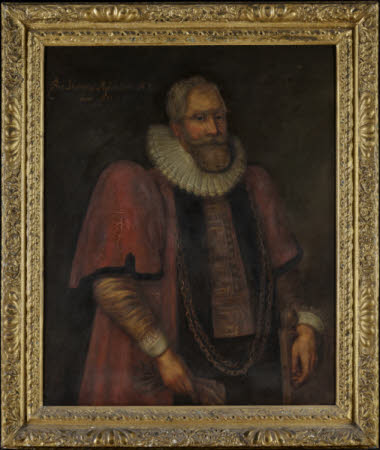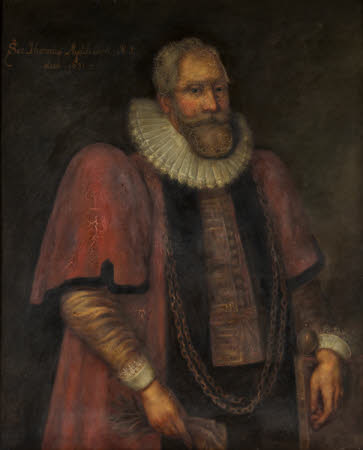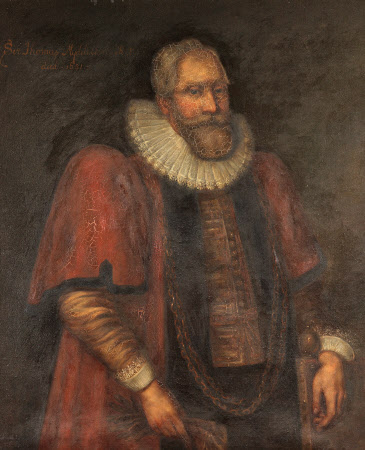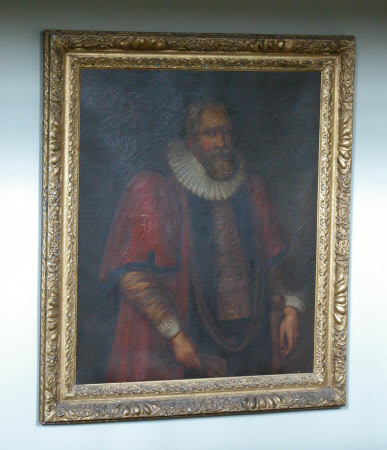Sir Thomas I Myddelton (1550-1631) as Lord Mayor of London, 1613
British (English) School
Category
Art / Oil paintings
Date
1902
Materials
Oil on canvas
Measurements
1280 x 1082 x 67 mm
Place of origin
England
Order this imageCollection
Chirk Castle, Wrexham
NT 1171100
Summary
Oil painting on canvas, Sir Thomas Myddelton I (c.1556-1631) as Lord Mayor of London, English School, 1902. A half-length portrait, turned three-quarters to right, with moustache and spade beard, large stiff pleated ruff, in the gown of the Lord Mayor of London (1613-14). A copy after an early 17th century portrait in the collection of the Guildhall Art Gallery, London (inv.no. 1345). Sir Thomas Myddelton I was a prominent figure in late-sixteenth-century sugar trading, in investment in privateering activities, and in the East India Company. Myddelton was apprenticed to the London grocer Fernandino Poyntz (fl. sixteenth century), became a sugar trader in Antwerp around 1583, and later acquired a sugar refinery in Mincing Lane, London. He married Hester (.d.1586), daughter of Richard Saltonstall (1521–1601). Myddelton became Freeman of the Grocer’s Company of London in 1582 and liveryman ten years later. He was a member of the Merchant Adventurers’ Company by 1585. Along with his brother, Robert (c.1563–1616), he was one of the first investors in the East India Company in 1599 and a member of the Virginia Company in 1609. Knighted in 1603, Myddelton became Lord Mayor of London in 1613. He helped finance the voyages of Sir Francis Drake ( c.1540–96) and Sir Walter Raleigh (1554–1618). He had a residence in the City of London and a country seat at Stansted Mountfichet in Essex. Myddelton bought Chirk in 1595, developing copper mines at Neath and investing in Welsh agriculture. A Puritan, he also he sponsored the first popular edition of the Bible in Welsh.
Full description
Associated with Chirk Castle
Provenance
With some of the contents, in 1978, that were acquired along with Chirk Castle from Lt-Col Ririd Myddelton (1902–1988) by the National Land Fund and handed, on loan for 99 years, to the Secretary of State for Wales (In 1981 Chirk was transferred into the ownership of the National Trust) On loan to the Trust from Guy Charles Myddelton. Gifted to Guy C Myddelton from Captain David Myddelton in 2010. Purchased by the National Trust from Mr Guy Myddelton in 2023.
Credit line
Chirk Castle, The Myddelton Collection (National Trust)
Marks and inscriptions
Top left: Sir Thomas Myddelton, K.t. / died. 1631 Verso: Inscribed on the back of the canvas in large red script: Sir Thomas Myddelton, Kt.: / bought Chirk Castle 1595 / buried at Stanstead Mounts-Fitchett / - Essex – 1631 –
Makers and roles
British (English) School, artist
References
Chirk Castle, 2003: [National Trust] 2003, p.36 Steegman 1957 John Steegman, A Survey of Portraits in Welsh Houses, Vol.I: North Wales, Cardiff, 1957, pp.83-84, no.2 Chirk Castle, 1971: An illustrated survey of the Historic Home of the Myddelton family, Jarrold, Norwich 1971, “The Staircase. Opposite the foot of the stairs hangs a portrait of Sir Thomas Myddelton who bought the castle in 1595, shown in his robes as Lord Mayor of London in 1613.”



